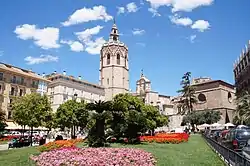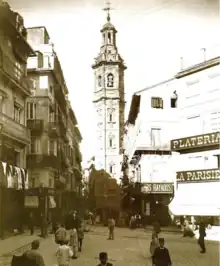Plaza de la Reina
Plaza de la Reina (Plaça de la Reina in Valencian and Queen's Square in English) is a central plaza in Valencia, Spain. It brings together, among others, Calle de la Paz, Calle del Mar, Calle del Cabilleros, Calle de los Bordadores, Calle de Santa Catalina, and Calle de Santo Vincente Mártir. The plaza includes the baroque door of the Irons, which gives access to the Valencia Cathedral. It is also noteworthy for views of two important bell towers of Valencia, the Santa Catalina and the Miguelete Tower.
| Plaza de la Reina | |
|---|---|
Plaça de la Reina | |
 Plaza de la Reina in Valencia looking toward the Valencia Cathedral | |
| Alternative names | Queen's Square |
| General information | |
| Type | Plaza |
| Location | València, Valencian Community, Spain |
| Town or city | Valencia |
| Country | Spain |
| Coordinates | 39.474513°N 0.375493°W |
| Construction started | 1868 |
| Completed | 1970 |
| Renovated | 2022 |
| Governing body | City of Valencia |
| Other information | |
| Parking | Underground garage |
Name of the Plaza
Plaza de la Reina is dedicated to Queen Mary of Mercedes of Orléans, first wife of King Alfonso XII, therefore the full name is Plaza de la Reina María de las Mercedes, or Queen Mary of Mercedes Square.[1] It did not always have this name because during the Republic it was called Plaza de la Región Valenciana and for a short period of time Plaza de Zaragoza. This name was used shortly after the disappearance of the old street of Zaragoza due to the demolitions necessary to form the open space that constitutes the square today. As citizens did not get used to the new name and continued to use the previous name "Plaza de la Reina", the city council decided to use the old name again, excluding the original name of Queen Mary of Mercedes.
History

The creation of the Plaza de la Reina begins with the Ecclesiastical confiscations of Mendizábal between 1835 and 1837. As a result of this seizure, the monastery of San José and the convent of Santa Tecla are demolished to create an opening for the Calle de la Paz. This results in a modest triangular plaza at the southern end of the current plaza.
Over the early years of the 20th century several plans were drawn up to expand the plaza. In 1911 a plan was proposed by Federico Aymami that would extend a boulevard from the Puente de Real to the northeast corner of the current plaza. This plan was never implemented.[4] In 1928 Javier Goerlich proposed a plan that was similar to Ayamai, but focused on the south end of the current plaza and including the demolition of Santa Catalina church, but not the belfry. This plan met opposition and again, nothing was done. In 1951 a contest was announced to draw up plans for an expansion and renovation of the plaza. Again, nothing was done, but demolition of buildings continued to open up the space with the final housing blocks demolished in 1963.[6]
In 1968, plans were accepted and work begun to build an underground parking garage in the plaza. This work was carried out by a private company under the direction of City Hall. The new plaza and parking garage were inaugurated in March 1970.
Renovation
In 2000, the College of Architects announced a competition to rebuild the Plaza de la Reina.[6] In 2015, the city announced plans to renovate the parking structure and pedestrianize the plaza using the winning plans of architects Miguel Del Rey, Iñigo Magro and Antonio Gallur.[8] In 2019, the city announced the renovation of the 11,000m2 plaza making it completely pedestrianized and the 1970 parking structure will be completely renovated. The parking garage will be adjusted to move the entrance, and it will accommodate 224 cars, 52 motorcycles, electric car charging stations, and bicycle parking. The fully pedestrian plaza will include benches and games as well as awnings to provide shade as the many new trees grow.[9] On 23 October 2020, the Ayuntamiento or City Hall approved a plan and awarded contracts for a €10,782,070 to UTE Escario Arquitectos-Tomás Llavador Arquitectos e Ingenieros-Auravall-Llogaritme and Edifesa will be in charge of project management.[10][11] The new plaza will be laid with 2,600 tons of stone and reforested with 112 new trees of 30 different species.[12] The work began in April 2021 after some delay.[11] In the process of the work, Visigoth remains were discovered. After some discussion, it was agreed with the Ministry of Culture that full archeological studies will be delayed to allow completion of the plaza renovation.[13]
Notes
References
- Ajuntament de València (2022-01-11). "La plaza de la Reina muestra ya parte de la nueva pavimentación y el aparcamiento rehabilitado" (in European Spanish). Retrieved 17 January 2022.
- Casañ Llopis, Vicente José (2016). De la autopista al bulevar. Trazado viario y espacio público en la Valencia contemporánea, 1946-1988 (unpublished doctoral thesis) (in European Spanish). València, Spain: Universitat Politècnica de València. Retrieved 16 January 2022.
- Corbín Ferrer, Juan Luis (1998). Del Miguelete a Santa Catalina (in European Spanish). Madrid: Federico Domenech SA.
- Jiménez, Toni (2019-11-22). "La plaza de la Reina de Valencia se transformará en un espacio verde con toldos, fuentes y juegos". ABC (in European Spanish). Retrieved 17 January 2022.
- Llopis, Amando (2004). Cartografía histórica de la ciudad de Valencia (1608-1929) (in European Spanish). València, Spain: Ayuntamiento Valencia.
- Navarro Rodríguez, Juan (2012). Metamorfosis de la Plaza de la Reina (in European Spanish). Valencia, Spain: Universitat Politecnica de Valencia. Retrieved 14 January 2022.
- Noguera, Juan Francisco (2000-12-14). "Una plaza para una Catedral. Concurso de remodelación de la Plaza de la Reina. Valencia". Loggia, Arquitectura & Restauración (in European Spanish). 9: 76–79. Retrieved 15 January 2022.
- Valencia Plaza (2020-10-23). "La reurbanización de la plaza de la Reina se adjudica por 10,7 millones de euros" (in European Spanish). Retrieved 16 January 2022.
- Valencia Plaza (2022-01-12). "Ayuntamiento y Generalitat dejarán tapados los restos en la Plaza de la Reina para futuros análisis" (in European Spanish). Retrieved 17 January 2022.
- Vázquez, Cristina (2015-07-15). "El Ayuntamiento de Valencia libera de coches la histórica plaza de la Reina". El País (in European Spanish). Retrieved 17 January 2022.
- Vázquez, Cristina (2021-04-26). "La reforma de la plaza de la Reina recupera la escala monumental de Santa Catalina, el Micalet y la Catedral". El País (in European Spanish). Retrieved 17 January 2022.